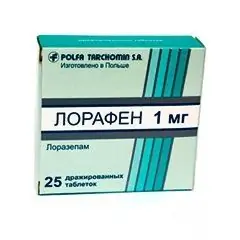Lorafen
Lorafen: instructions for use and reviews
- 1. Release form and composition
- 2. Pharmacological properties
- 3. Indications for use
- 4. Contraindications
- 5. Method of application and dosage
- 6. Side effects
- 7. Overdose
- 8. Special instructions
- 9. Application during pregnancy and lactation
- 10. Use in childhood
- 11. In case of impaired renal function
- 12. For violations of liver function
- 13. Use in the elderly
- 14. Drug interactions
- 15. Analogs
- 16. Terms and conditions of storage
- 17. Terms of dispensing from pharmacies
- 18. Reviews
- 19. Price in pharmacies
Latin name: Lorafen
ATX code: N05BA06
Active ingredient: lorazepam (Lorazepam)
Manufacturer: JSC "Tarkhominsk pharmaceutical plant" Polfa "(Poland)
Description and photo update: 2019-08-10

Lorafene is an anxiolytic drug, tranquilizer (benzodiazepine derivative).
Release form and composition
The drug is available in the form of coated tablets: round, biconvex; tablets with a dosage of 1 mg - white or almost white, with a dosage of 2.5 mg - pink (25 pcs. in blisters of aluminum foil, in a cardboard box 1 blister and instructions for use of Lorafen).
1 tablet contains:
- active substance: lorazepam - 1 or 2.5 mg;
- auxiliary components: lactose, potato starch, magnesium stearate, sodium carboxymethyl starch, gelatin, talc; additionally for tablets with a dosage of 2.5 mg - crimson dye (Ponso 4R);
- shell: sucrose, polyvinyl alcohol, maltodextrin, titanium dioxide, talc; additionally for tablets with a dosage of 2.5 mg - crimson dye (Ponso 4R) aluminum varnish.
Pharmacological properties
Pharmacodynamics
Lorafen is an anxiolytic drug (tranquilizer) with sedative, hypnotic, anticonvulsant, central muscle relaxant and antiemetic effects. Its active ingredient, lorazepam, belongs to the group of 1,4-benzodiazepine derivatives and has an effect on many structures of the central nervous system (CNS), including those associated with the regulation of emotional activity (limbic system, hypothalamus). Anxiolytic, sedative and hypnotic effect of Lorafen is due to an increase in the inhibitory effect of gamma-aminobutyric acid (GABA) in the central nervous system, anticonvulsant - by an increase in presynaptic inhibition. Against the background of suppression of the spread of epileptogenic activity that appears in epileptogenic foci in the cortex, limbic structures and thalamus, the excited state of the focus is not removed. The muscle relaxant effect is primarily a consequence of the suppression of spinal polysynaptic afferent pathways and, in all likelihood, inhibition of monosynaptic afferent pathways. In addition, a direct inhibitory effect on motor nerves and muscle function is possible.
Pharmacokinetics
After taking Lorafen inside, lorazepam is well absorbed from the digestive tract. Its maximum concentration in the blood is reached after 2 hours and while taking 2 mg of lorazepam it can be 20 ng / ml.
Binding to blood proteins - 85%.
Lorazepam crosses the blood-brain and placental barriers, passes into breast milk.
It is metabolized in the liver by conjugation with glucuronic acid to form an inactive metabolite - lorazepam glucuronate.
The half-life (T 1/2) is approximately 12 hours.
It is excreted through the kidneys in the form of lorazepam glucuronate.
Indications for use
- neurosis-like and neurotic states, accompanied by increased fatigue, anxiety, sleep disturbances, irritability, autonomic disorders;
- hypertonicity of skeletal muscles of various origins;
- alcohol withdrawal syndrome - as part of combination therapy;
- long-term diagnostic procedures and operations - as a premedication.
Contraindications
Absolute:
- states of anxiety or mental stress caused by everyday problems;
- severe respiratory failure of any genesis;
- sleep apnea syndrome;
- psychosis;
- severe hepatic and / or renal impairment;
- glaucoma;
- acute porphyria;
- myasthenia gravis;
- alcohol poisoning;
- alcohol dependence (during the period and within three days after the completion of treatment, alcohol is not allowed);
- hereditary lactose or fructose intolerance, Lapp lactase or sucrase-isomaltase deficiency, glucose-galactose malabsorption syndrome;
- breast-feeding;
- age up to 12 years;
- hypersensitivity to 1,4-benzodiazepine derivatives or drug components.
Lorafen should be taken with caution in case of mild and moderate hepatic and / or renal failure, chronic respiratory failure, suicidal thoughts and attempts at history, depression, porphyria, cerebral and spinal ataxia, hyperkinesis, hypoproteinemia, organic pathologies of the brain, alcoholic, drug or a history of drug addiction, in old age, during pregnancy.
Lorafen, instructions for use: method and dosage
Lorafen tablets are taken orally with plenty of water.
The patient must strictly adhere to the dosage regimen and duration of treatment established by the attending physician.
Recommended dosage for patients over 12 years of age:
- neurotic and neurosis-like states: the initial daily dose is 2-3 mg, divided into 1-3 doses. If necessary, the initial dose of Lorafen is gradually increased until a sufficient clinical response is achieved, starting with the evening dose. The maintenance daily dose is 2–6 mg, divided into 1–3 doses. The lowest effective dose should be used to relieve anxiety symptoms. The maximum daily dose is 10 mg;
- sleep disturbances caused by anxiety: 2–5 mg once before bedtime;
- premedication: on the eve of a diagnostic procedure or surgery - 2–5 mg per night, then additionally on the day of the procedure - 2–5 mg 1–2 hours before the immediate procedure or surgery.
Cancellation of Lorafen should be carried out gradually according to the individual scheme recommended by the doctor. The maximum duration of the course of treatment is 28 days (including the period of gradual withdrawal of the drug), for symptomatic treatment of anxiety disorders - from several days to two weeks. In some cases, after assessing the patient's condition, the doctor may decide to extend the course of therapy.
For the treatment of elderly patients, use the lowest effective dose of Lorafen. The clinical effect can be achieved by prescribing a dose equal to 1/2 of the usual dosage regimen.
In mild to moderate hepatic and / or renal insufficiency, the dose should be selected individually, taking into account the severity of functional disorders of the kidneys and / or liver.
Accidental missed doses cannot be compensated for by taking a double dose of Lorafen.
Side effects
- on the part of the nervous system: more often in elderly patients - dullness of emotions, drowsiness, dizziness, increased fatigue, decreased ability to concentrate, lethargy, ataxia (loss of balance against the background of unsteadiness of gait and poor coordination of movements), slowing down of mental and motor reactions, muscle atony, disorientation; rarely - headache, confusion, euphoria, dystonic extrapyramidal reactions (including uncontrolled eye movements), depression of mood, catalepsy, myasthenia gravis during the day, dysarthria, amnesia, tremor, depression; very rarely - paradoxical reactions (including fear, confusion, hallucinations, aggressive outbursts, muscle spasm, suicidal tendencies, acute agitation, irritability, anxiety, insomnia);
- on the part of hematopoietic organs: neutropenia, leukopenia, thrombocytopenia, agranulocytosis (hyperthermia, chills, sore throat, weakness), anemia;
- from the digestive system: drooling, dry mouth, nausea, vomiting, heartburn, decreased appetite, diarrhea, constipation, liver dysfunction, jaundice, increased activity of hepatic transaminases, alkaline phosphatase and lactate dehydrogenase;
- from the senses: diplopia;
- from the genitourinary system: impaired renal function, urinary incontinence, urinary retention, dysmenorrhea, increased or decreased libido;
- allergic reactions: skin rash (including urticaria, erythematosis), pruritus; very rarely - anaphylactic reactions;
- others: drug dependence, addiction, lowering blood pressure (BP); rarely - tachycardia, depression of the respiratory center, weight loss, bulimia; against the background of a sharp dose reduction or discontinuation of therapy, withdrawal syndrome may occur, accompanied by nausea, vomiting, irritability, fear, perspiration, increased sweating, sleep disturbance, excitement, agitation, headache, anxiety, nervousness, dysphoria, spasm of smooth muscles of internal organs and skeletal muscles, myalgia, depersonalization, depression, tremor, perceptual disorder (including paresthesia, photophobia, hyperacusis), tachycardia, convulsions, hallucinations, in rare cases - acute psychosis.
Overdose
Symptoms: slurred speech, drowsiness, disorientation, in severe cases of overdose - loss of consciousness, coma. Poisoning caused by the combination of lorazepam with alcohol or other drugs with a depressing effect on the central nervous system is life-threatening.
Treatment: immediate gastric lavage or induction of vomiting, intake of activated charcoal, careful monitoring of the patient's condition, monitoring of all basic vital functions, including blood pressure, respiration, pulse; the appointment of symptomatic therapy. The specific antidote is flumazenil.
special instructions
Lorafene should be used only as directed and under the strict supervision of a physician. If after 7-14 days of therapy there is no dynamics of symptom relief or a relapse of the disease is observed, then the patient should consult a doctor.
It should be borne in mind that against the background of regular intake of lorazepam for several weeks, the development of tolerance is possible, which may lead to a decrease in the clinical effect of Lorafen. In addition, there is a risk of psychiatric or physical drug dependence in the patient, which increases with increasing dose and duration of treatment. Patients with a history of alcohol, drug and drug dependence are most likely to develop drug dependence.
Abrupt cessation of treatment with Lorafen for drug addiction can cause the development of withdrawal symptoms, the characteristic manifestations of which include headache, sleep disturbance, emotional stress, psychomotor agitation, irritability, muscle pain, disorientation, confusion, and motor restlessness. Severe cases may be accompanied for the patient by the loss of a sense of the reality of the environment (derealization), personality disorder (depersonalization), hallucinations, increased sensitivity to touch (tactile hyperesthesia) and auditory or visual stimuli (acoustic and light hyperesthesia), numbness of the extremities, a feeling of "creeping" or seizures. Of particular danger are pronounced manifestations of withdrawal symptoms,the occurrence of which is more often associated with abrupt withdrawal of lorazepam, used in doses exceeding average, for a long time.
The physician should inform the patient about the possibility of a temporary recurrence of symptoms after the end of treatment with a greater severity than initially (the so-called "rebound" insomnia). Symptoms are often accompanied by mood changes, fear, and increased physical activity. Timely informing will reduce patient anxiety, since the severity of these symptoms can be quite high.
It should be borne in mind that when Lorafen is abruptly canceled, the risk of withdrawal symptoms or insomnia of the "rebound" type increases.
To minimize the risk of developing antegrade amnesia, it is recommended to take the tablets half an hour before going to bed and to provide the patient with conditions for uninterrupted sleep for at least 7 hours.
During therapy with Lorafen, paradoxical reactions may develop (including severe sleep disturbance, nightmares, psychomotor agitation, irritability, aggressiveness, hallucinations, depersonalization disorder, psychosis, somnambulism), which are more often observed in elderly patients and require immediate discontinuation of treatment.
For the treatment of depression or related anxiety, Lorafen should not be used as monotherapy, since benzodiazepines can aggravate suicidal tendencies in patients. When prescribing, the lowest effective dose should be used.
It should be borne in mind that the use of lorazepam with a history of alcohol, drug or drug dependence is associated with an increased risk of developing mental and physical dependence or addiction.
Long-term use of Lorafen should be accompanied by periodic blood and urine tests.
The use of alcoholic beverages during the treatment period and within three days after its completion is contraindicated.
Influence on the ability to drive vehicles and complex mechanisms
During the period of application of Lorafen and within three days after its cancellation, patients should not be engaged in potentially hazardous activities, including driving vehicles and complex mechanisms.
Application during pregnancy and lactation
Lorazepam has a teratogenic effect on the fetus. In newborns whose mothers took the drug during the period of gestation, respiratory failure occurs, the sucking reflex is suppressed.
In the presence of absolute indications, lorazepam may be taken during pregnancy only in cases where alternative therapy with a less dangerous agent is not possible.
The use of Lorafen is contraindicated during breastfeeding. If necessary, the appointment of the drug during lactation, breastfeeding should be discontinued.
Pediatric use
Lorafen is contraindicated for the treatment of children under 12 years of age due to the lack of information on the safety and efficacy of lorazepam in this category of patients.
With impaired renal function
The appointment of Lorafen is contraindicated in severe renal failure.
Patients with mild to moderate renal failure should take the drug with caution.
For violations of liver function
The appointment of Lorafen is contraindicated in severe hepatic failure.
Patients with mild to moderate hepatic impairment should take the drug with caution.
Use in the elderly
Great care should be taken when using Lorafen in patients over the age of 65 years due to the increased risk of adverse events from the nervous system, as well as side effects associated with impaired coordination of movements and orientation.
Drug interactions
- opioid analgesics, centrally acting antihypertensive drugs, anesthetics (general anesthetics), antidepressants, psychotropic or antihistamines: against the background of concomitant therapy with the listed drugs, the inhibitory effect of lorazepam on the central nervous system is enhanced;
- ethanol: alcohol consumption can cause the development of paradoxical reactions (including aggressive behavior, psychomotor agitation), due to a depressing effect on the central nervous system, enhance the sedative effect of lorazepam up to coma;
- muscle relaxants: lorazepam prolongs and enhances the effect of drugs with muscle relaxants;
- erythromycin, ketoconazole, disulfiram, cimetidine: a combination with inhibitors of cytochrome P 450 isoenzymes slows down the biotransformation of lorazepam and enhances its inhibitory effect on the central nervous system;
- rifampicin, phenytoin, carbamazepine, phenobarbital: the effect of these and other inducers of cytochrome P 450 activity leads to a weakening of the pharmacological action of the benzodiazepine derivative;
- theophylline, caffeine: by stimulating the central nervous system, may weaken the hypnotic effect of lorazepam. In addition, they are able to activate liver enzymes that are responsible for the metabolism of drugs. It should be borne in mind that smokers may not have this effect;
- oral contraceptives: the use of oral contraceptives can increase the metabolism and decrease the T 1/2 of lorazepam.
Analogs
Lorafen's analogs are: Lorazepam, Elzepam, Merlit, Loram, Diamidazepam, Librax, Tenoten, Alprazolam, Alprox, Zolomax, Xanax retard, Neurol, Phenibut, Amide phenylhexanoylglycyl tryptophan, Anvipominezam, Loproxotenitone, Hydroxyzine, Diazepam, Relium, Seduxen, Elenium, Adaptol, Mexiprim, Mexifin, Apo-Lorazepam, etc.
Terms and conditions of storage
Keep out of the reach of children.
Store at temperatures up to 25 ° C, protected from moisture and light.
Shelf life is 2 years.
Terms of dispensing from pharmacies
Dispensed by prescription.
Reviews about Lorafen
The few reviews about Lorafen are positive. Patients indicate the effectiveness of the drug in the treatment of neurotic conditions. Regular intake of Lorafen ensures normal sleep and emotional peace. The disadvantages include the rapid onset of drug dependence.
The price of Lorafen in pharmacies
Due to the lack of the drug in the pharmacy chain, the price of Lorafen is currently unknown. Analogue Elzepam can be purchased for 60 rubles. (in a package of 50 tablets of 1 mg).

Anna Kozlova Medical journalist About the author
Education: Rostov State Medical University, specialty "General Medicine".
Information about the drug is generalized, provided for informational purposes only and does not replace the official instructions. Self-medication is hazardous to health!







